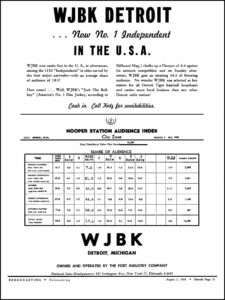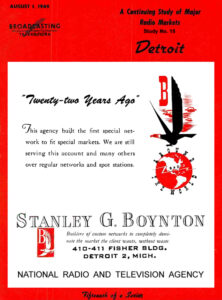 75 Years Ago, This Month, Broadcasting Magazine Reported In-Depth On the Status of the Radio Market in Detroit — Part 3
75 Years Ago, This Month, Broadcasting Magazine Reported In-Depth On the Status of the Radio Market in Detroit — Part 3
Note: Missed Chapter Two? Go HERE.
_____________________
At Kenyon & Eckhardt, Don Miller is account executive on the Lincoln-Mercury business. Like Ford, L-M has been active recently only in TV, sponsoring Toast of the Town on CBS-TV. This show is live in the East, plus Detroit and Chicago, and kinescoped to the rest of the network. K&E also has the Detroit L-M dealers who are buying spots on all three local TV stations, plus weather reports over WXYZ-TV.
Packard Motor Co. has only one show going now, a WWJ-TV presentation of the George Scotti Show. Young & Rubicam, which just celebrated its 18th year as agency for Packard, handles the show.
 Ford, in a surprise move in May, announced that its entire effort on the air was going to be concentrated on TV. The AM Ford Theatre was dropped as of July 1 and the entire budget thrown to the Ford Television Theatre, which is to go to every other week in October, with tentative plans for weekly operation after the first of next year. The Ford Dealers fell into line with this policy by dropping the Fred Allen Show at the conclusion of this season.
Ford, in a surprise move in May, announced that its entire effort on the air was going to be concentrated on TV. The AM Ford Theatre was dropped as of July 1 and the entire budget thrown to the Ford Television Theatre, which is to go to every other week in October, with tentative plans for weekly operation after the first of next year. The Ford Dealers fell into line with this policy by dropping the Fred Allen Show at the conclusion of this season.
Note: Mouse click over (pc) or tap and stretch (mobile screen) over the WJBK ad image for largest detailed read.]
The dealer TV offering, through the Crystal Ball, is being sponsored by the 16 sales districts that have TV outlets in their area. (There are 33 Ford sales districts, with 21 of them handled by the Detroit office of J. Walter Thompson Co.) Eight of them are using TV spots or short programs, including the Detroit Dealer buy of Baseball Scoreboard on WXYZ-TV, which gives the results of all major league games seven days a week. In the AM field, however, only one district is active in spots at present, the Denver area using a schedule on used cars.
This picture is subject to change with practically no notice, however, and in view of the dropping of the Allen show, the budget may allow for more in the way of spots. Last year, when the 1949 Ford was introduced, all 21 of the Detroit-handled districts used a large schedule of spots.
Getting a little car-sick? Let’s settle your nerves with another quick look at this enormous market, big and active enough to soothe the most ambitious salesman.
Though Detroit is 1,000 miles from the nearest ocean, it still ranks second only to New York as a customs district, largely because of the city’s heavy trade with Canada, the second largest customer of the U. S. Over the river to Windsor, Ont., soars the Ambassador Bridge, while the Fleetway Tunnel burrows beneath the water.
The river forms a natural harbor, and the banks are lined with wharves and elevators, helping to handle the north and southbound ore, grain and automobile shipping. Five major railroads service the Detroit area, plus several smaller lines and scores of trucking systems.
Leading products include automobile bodies, parts and accessories, steel and pig iron, brass products, pharmaceuticals, heavy chemicals, paints and varnishes, stoves and furnaces, electric appliances, machinery, foundry products, tools, dies, gauges, jigs and fixtures, adding and calculating machines, soda ash, salt, cleaning compounds, screw machine products and cutting tools.
One of the important things to remember about Detroit is the large foreign speaking population, a classification in which the city ranks third in the nation. Hamtramck, a city completely surrounded by Detroit, has a population of over 300,000, mostly of Polish extraction. There are also strong nationality centers of Italians, Slavs, Irish, Greeks and many others, though each year brings a more thorough breaking -up of the old tendency to huddle together in nationality groups.
The market is big in every sense of the word. Last year, estimates of the value of the Wayne County factory product value were $7.9 billion. The highly paid workmen of the factories didn’t do badly, either, taking home $1,530,000,000 as their share of the bounty. The high wages of the factories in the area have had their effect on the wages of every other trade and profession. Employees of the Detroit Street Railway, a municipally owned transportation system, are among the highest paid workers in their classification in the country.
And lest the use of 1948 figures bring the suspicion that 1949 figures haven’t kept pace, the April 25 issue of the Board of Commerce paper, The Detroiter, shows that whatever the rest of the country thinks of a recession, Detroit is too busy turning out goods to worry about it. With 498,000 factory workers employed during the first three months of 1949 (a gain of 24,000), they had raised their weekly average pay to $66.89, with factory payrolls at $33 million weekly increases over the same 1948 period of 5.1 %, 8.7 %, and 14.2%, respectively.
Though department store sales were down 5 %, most of this was attributed to the later Easter date, and in any case, the increase of $21 million in bank savings, and $6.6 million in E Bond holdings, reflected that Detroiters still had the wherewithal. With the slight downward movement of living costs, the area’s purchasing power is expected to remain on the upgrade.
The tobacco industry was one of the brightest spots in the 1948 U. S. sales picture, producing 352 billion cigarettes, and Detroit didn’t hurt sales a bit, buying one out of every 25 packages sold. Produce is another item that ranks high in big business in Detroit, for the Produce Terminal reported the unloading of 30,248 carloads of fresh fruits and vegetables.
Naturally, Detroit as a home-loving city, specializes in brides. The city had 26,077 marriages in 1948, and multiplying this by the national estimate of $4,900 in merchandise and gifts that brides are directly or indirectly responsible for, shows a sub-market in Detroit of $127,777,000, and not all in silver butter dishes! If it’s baby foods or diapers you’re selling, 48,148 new customers came to Detroit in 1948, only 2,000 less than the all-time high of 1947.
While Detroit has its feet in the factories, it also has a place in its heart for the arts. The Art Center, just north of downtown, includes the $4 million Italian Renaissance style Institute of Arts, the white marble Public Library, and the Rackham Memorial, center of the city’s engineering societies.
A mecca for tourists as well as residents is the Ford Foundation in near-by Dearborn, where Henry Ford recreated a replica of an age gone by in beautiful Greenfield Village. Detroit has the largest Masonic Temple in the world, with two floors occupied by Fort Industry’s WJBK and WJBK-TV.
Four major airports serve the Detroit area. The Municipal Airport on the east side, just 10 minutes from downtown, is one of the country’s busiest, handling just air freight and private plane traffic. With the increased use of four-motored planes, all the passenger airlines moved out to the giant Willow Run Airport, site of the Ford B-24 building operations during the war.

The 30-mile trip from downtown to Willow Run has been a sore point with Detroiters and they are solving it in a typical way by making a tentative agreement with Canada to build an international airfield just outside Windsor, only 12 minutes from Detroit.
Such a city was bound to develop some outstanding advertising agencies, agencies which have been consistent radio users in both the national and the local fields. They tend to the conservative side, with a minimum of account shifting, but are prominent in the creation of new commercial programs and ideas, and able new business departments specialize in the development of retail advertisers.
One of the most outstanding jobs of radio promotion ever used anywhere in the country is the drug chain sponsored Cunningham News Ace, a series of 5, 10, and 15-minute newscasts on every Detroit station. These broadcasts have now passed the 75,000 mark, and are still going at the rate of 117 each week. The high mark came in 1946, when the News Ace “came zooming into your home” 185 times every seven days.
Using a unique plan of product manufacturer cooperation, the firm has had unrivaled success in its field. The chain has now expanded to over 100 stores in 17 Michigan cities. It is also a consistent buyer of programs before and after leading sports events, including the Paul Williams Sports Ace before Tiger home games, and Football Panorama in the fall. Larry Michelson, of Simons-Michelson, handles the Cunningham account personally, and is known as one of radio’s strongest boosters in the area.
Each year Cunningham puts on an anniversary sale backed by saturation use of radio. One year it bought all spots available on every Detroit station. Another landmark came when it brought the Don McNeill Breakfast Club to Detroit and broadcast the hour long show on all six of the city’s AM stations.
At the same time, Cunningham jumped into the TV picture as well, sponsoring the area telecast of Cavalcade of Stars in conjunction with nine drug chains in other cities.
Simons-Michelson will celebrate the twentieth anniversary this year of the Leonard N. Simons-Lawrence J. Michelson partnership. One of the foundation stones of the firm has been the all-out effort of both the partners on behalf of every community welfare and public service drive. Invariably, the fund raising drives of Detroit’s charities will list one or the other as publicity and advertising chairman.
Marian Sanders is radio and television director for S-M, assisted by Rudy Simons, son of Detroit’s famous songwriter and band leader, Seymour Simons. These two were thrown headlong into the production of filmed TV commercials when a promised commercial for an early TV client didn’t come through.
Dragging a cameraman with them, the two utilized any props they could to do the job, including Marian’s fiance and her own apartment. The agency became experts on paste-up commercials through clients’ insistence that production costs be held to a minimum, one even offering $20 for the costs on 10 jobs! They still insist that it doesn’t take a lot of money for the small advertiser to get into television if he will only use his budget in the smartest way. MCRFB: to be continued next week . . . .
 This feature is a special Broadcasting series about Detroit radio. This was first released by the publication on August 1, 1949. It will continue as an exclusive presentation every Tuesday on this site throughout August and for two weeks in September, for a total of six weeks.
This feature is a special Broadcasting series about Detroit radio. This was first released by the publication on August 1, 1949. It will continue as an exclusive presentation every Tuesday on this site throughout August and for two weeks in September, for a total of six weeks.
Originally published in Broadcasting magazine under the title “The Detroit Radio Market,” this extensive article will be presented in six parts, continuing in sequential chapters.
The 1949 article provides valuable insights into the state of radio in Detroit during the late 1940s decade, as it was, then, seven decades ago.
![]()








